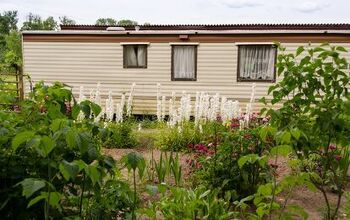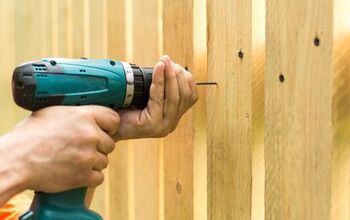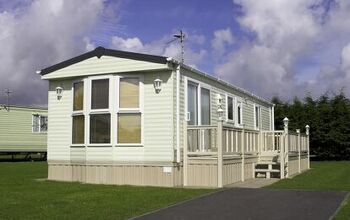Can You Put Up A Fence In A Mobile Home Park? (Find Out Now!)

You have lived in a mobile home for a while now, and you have enjoyed living in a mobile home park more than you ever thought you would. Now, you’ve saved up a bit of extra money, and you’d like to put up a fence around your mobile home both to enhance the look and to give your family more privacy. However, you don’t know where to start.
You don’t even know if you are allowed to put up a fence in a mobile home park. What type of fence would you put up if you were allowed to? What other ways can I create privacy around my mobile home? Here are the answers to your questions.
You can put up a fence in a mobile home park, but you must have your landlord’s permission and a permit from the city or county you live in. You will only be able to get a permit if you live in an area where there is no ordinance prohibiting fences.
Do You Need Fence Installation or Repair Services?
Get free, zero-commitment quotes from pro contractors near you.

What Determines If You Can Put Up a Fence in a Mobile Home Park?
Whether you can put up a fence in a mobile home park is based upon the zoning laws in the city or county where you live and whether the landlord gives you permission to build it. If local zoning laws don’t allow it, you can’t purchase a permit to construct a fence.
Actually, most mobile home parks already have a fence just inside the edge of the property line surrounding the property. If you are allowed to construct a fence in your mobile home park, what type of fence will you choose? We can help with this information.
Mobile Home Fencing Ideas
You have gotten a permit and checked with your landlord. Now, it’s time to build your fence. Will you use the same type of fence that your landlord used to enclose the park so that it will match? What types of fences would work well in a mobile home park? Here are some suggestions for fencing in a mobile home park.
Shrub FencingIt is a bad idea if you don’t get much rain where you live, but planting shrubs for “fencing” is an excellent idea. You can plant seeds and watch them grow up into bushes, or you can buy fully grown bushes and plant them. Of course, with the former, you will have to wait quite some time before your plants actually give you any privacy. There are two relevant things to remember about the latter. Fully mature bushes will give you privacy immediately, and it won’t be cheap.
When I say that, though, it may be cheaper than actual solid fencing. You can even use both, using the bushes to disguise the fence. Many types of bushes work well for fencing. The following bushes grow fast and do a great job as privacy bushes: traditional lilac, yew, burning bush, cherry laurel, privet, loropetalum, beautyberry, forsythia, mock orange, pussy willow, leylandii cypress, amur maple, cherry laurel, arborvitae, cotoneaster, red twig dogwood, and more.
You must, however, live in an area that gets plenty of rain or where you are able to provide irrigation to your plants to keep them alive and thriving.
Metal FencingMetal security fencing seems to work well in mobile home parks. It is amazingly sturdy, able to withstand a moving automobile crashing into it if installed correctly. You will want to paint this type of fencing to make it appealing. It is very likely that your mobile home park is already surrounded by this type of fencing, and if it is, you may want to paint to match it. Otherwise, know that dark colors work better. You could paint your fence similar to your mobile home or the trim on it.
White Vinyl FencingWhite vinyl fencing appeals to the eyes. It gives off an air of style and elegance. Plus, white vinyl fencing is one of the cheapest types of fencing you can buy. Here are two types of white vinyl fencing you may enjoy.
White Vinyl Solid FencingWhite vinyl solid fencing is normally used to hide something that’s terribly unattractive, like a neighboring property with junk cars and tall grass everywhere. It lasts forever and needs only cleaning every once in a while, if you are so inclined, because you won’t need to paint it. It would also be a perfect canvas for a good outdoor artist. You could have one come and personalize the fence on your side with whatever theme you’d like.
White Vinyl Three-Rail FencingThis is the most eye-appealing type of fencing. Its vibe is a bit upscale and classy, and it costs little in comparison to metal fencing. There is also two-rail and four-rail fencing, if you prefer, but three-rail is the best look. Like white vinyl solid fencing, it never needs painting, and it lasts indefinitely.
Other FencingOther choices include wood, PVC, and chain-link fencing with wood slats inserted. Wood fences can be lovely, but make sure you use treated wood. Also, know that they are high-maintenance; they will need to be painted every year or two. PVC fencing is really cheap compared to other types of fencing but isn’t as durable as vinyl fencing. Chain-link fencing with wood slats is something you don’t see very often anymore. However, it does do the job, and you can stain or paint the wood to match your mobile home.
Mobile Home Privacy Ideas
There are other ways besides to get some privacy in and around your mobile home. You just have to be creative. Here are some ideas to create privacy on your mobile home property.
Retractable Backyard ScreenA retractable backyard screen is one way to keep sneaky eyes from getting into your business. They are available online at Amazon or at home improvement stores both online and at brick and mortar stores. They will, however, need to be anchored to concrete with concrete fasteners or to wood subfloors, like those in a patio or deck.
DIY Backyard Privacy ScreensIt’s not hard to build a privacy screen or “fence,” and the great thing is that you can be creative. You can make the design your own. You can use materials of your choice, colors of your choice, and follow a design from the internet or create one all your own. You can find all kinds of cheap materials at yard sales and thrift stores.
Non-retractable Backyard Screens
You can also purchase pre-built screens made from wicker, wood, or metal, depending on your personal preference. These screens either stick down into the ground and must be set into concrete or a wood subfloor or have heavy legs that come out toward the front and the back that must be fastened down into the concrete or wood subfloor.
Backyard Trellis With Curtains or BlindsYou can also build or have built a trellis over the exit of your mobile home into the backyard and hang curtains or blinds. This is a wonderful idea, because it has an elegant look to it. If your mobile home is white and blue, you can have a white trellis and hang blue curtains or have a blue trellis and hang wicker blinds. If you go with curtains, but it’s windy where you live, you can hang another curtain rod at the bottom from post to post and run the bottom of the curtain through it to keep your curtains in place.
Brick or Stone WallsMost people that live in mobile homes don’t have this kind of money, but if you just inherited a small lump sum and want to put it toward classy privacy, have a brick or stone wall built, at least on the side that most importantly needs to be blocked. This is a lovely and sophisticated way to keep nosey people out of your business.
Do You Need Fence Installation or Repair Services?
Get free, zero-commitment quotes from pro contractors near you.

What Is the Legal Distance Between Mobile Homes?
How much distance must be between mobile homes is a question of zoning laws. Local ordinances can also play a part. Therefore, it can vary from city to city and county to county. Within city limits, a single-wide mobile home must be a minimum of 40 feet away on every side of an adjacent property line. A double-wide must be 60 feet away, and a triple-wide must be 100 feet away. This is nationwide. If these guidelines are not met, you are encroaching upon your neighbor’s land.
In the U.S., no law prohibits you from building a mobile home on a property that holds an existing home. While there exists no law regarding the distance between mobile homes built on separate foundations, you must leave enough space to accommodate that home’s parking area and access routes.
To find out what the zoning laws are where you live, you should contact your local building inspector’s office or zoning department. Whatever the law is where you live, it is important to know, because unless you meet this requirement, local authorities and insurance companies won’t deem your mobile home as a legal living space.

We are a team of passionate homeowners, home improvement pros, and DIY enthusiasts who enjoy sharing home improvement, housekeeping, decorating, and more with other homeowners! Whether you're looking for a step-by-step guide on fixing an appliance or the cost of installing a fence, we've here to help.
More by Upgraded Home Team


























![How To Reset A Whirlpool Cabrio Washer [In 5 Easy Steps!]](https://cdn-fastly.upgradedhome.com/media/2023/07/31/9076531/how-to-reset-a-whirlpool-cabrio-washer-in-5-easy-steps.jpg?size=350x220)
